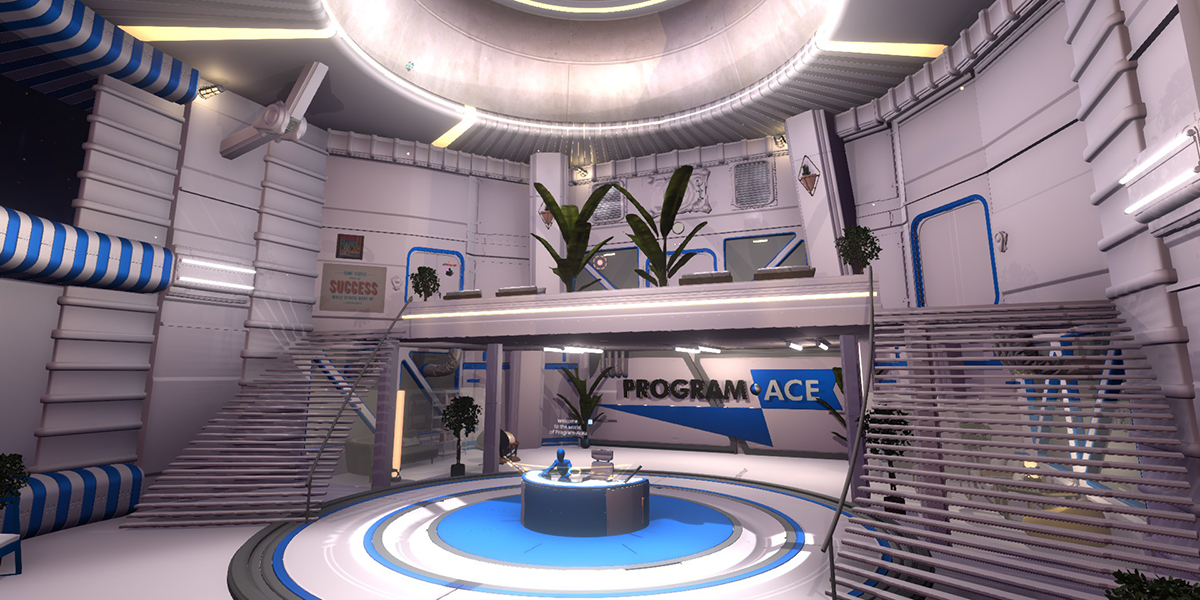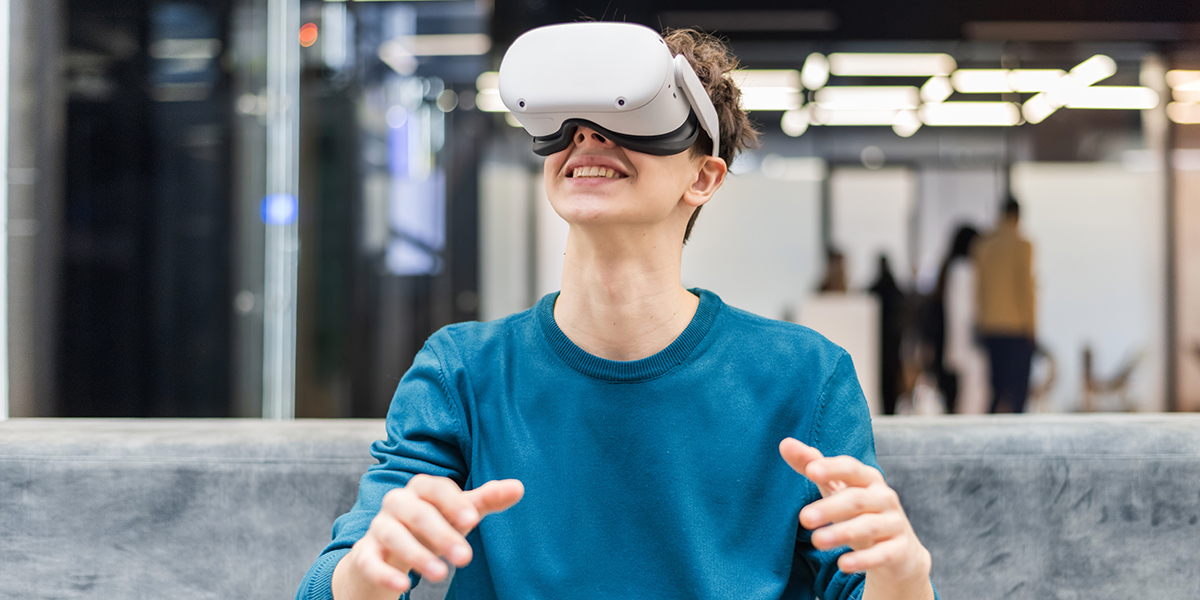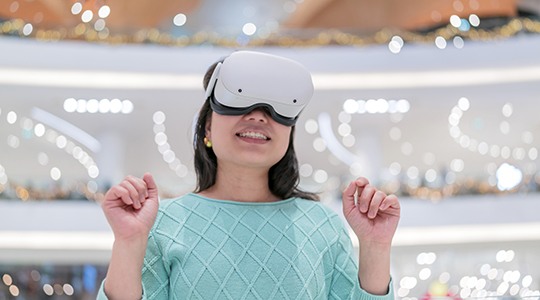Stepping into the digital frontier presents a crucial intersection where real-world experiences blend seamlessly with the expansive possibilities of imagination. Here, the metaverse unfolds as a vast network of interconnected digital spaces thoughtfully designed by the innovative minds at a metaverse development company. In parallel, the domain of virtual reality (VR) is vividly realized through cutting-edge technological advancements spearheaded by industry-leading tech corporations.
While the metaverse and virtual reality maintain distinct identities, they share a common vision: redefining how we engage with digital spaces. The dialogue surrounding metaverse vs. virtual reality and metaverse vs. VR brings their unique characteristics and contributions to light. The metaverse is envisioned as an extensive, interlinked universe of digital environments, whereas virtual reality focuses on creating deeply immersive experiences within more defined settings.
As we explore this digital terrain further, we are encouraged to dissect the differences and individual strengths of the metaverse and VR. Which will lead us toward a more enthralling and interconnected digital future? In our journey to decode the metaverse's mysteries and virtual reality's immersive capabilities, we are invited to ponder their roles in reshaping our digital interactions.
Imagine a future where the lines between reality and virtual reality blur. It's fascinating to consider where we might find ourselves within this evolving digital narrative. As we set out to uncover the vast environments of the metaverse and the rich, immersive experiences offered by virtual reality, we are drawn into the promise of a transformed digital existence.
What Is a Metaverse? — Revelations in a Nutshell

So, a question frequently arises: what is the metaverse, and how does it relate to virtual reality? While there is a certain degree of overlap between the two, understanding their differences is key to recognizing the unique qualities of each technology.
Virtual reality is known for providing a deeply immersive experience, typically within the confines of a specific application or game. Users are transported into an alternate environment, one that is visually and audibly distinct from their physical surroundings. Recent advancements in both the hardware and software associated with virtual reality have significantly enhanced the depth of immersion possible, allowing individuals to experience unprecedented levels of engagement within these virtual settings.
Conversely, the metaverse is envisioned as a vast and interconnected network of digital environments. It represents a persistent, evolving digital cosmos where individuals can transition smoothly between a multitude of experiences. The relationship between the metaverse and VR is intricate, as they both contribute to the broader spectrum of digital immersion and interactivity, yet each stands out for its distinct characteristics.
The differentiation between metaverse vs. virtual reality and metaverse vs. VR is a topic of ongoing discussion. The metaverse extends beyond the immersive experiences of virtual reality to encompass a broader digital ecosystem. This ecosystem is made up of diverse virtual spaces that are interconnected, allowing for continuous existence and interaction akin to the continuity found in the physical universe.
Technopedia defines the metaverse as a comprehensive, interconnected digital universe, amalgamating various forms of reality — virtual, augmented, and physical — into a cohesive, shared space where interactions occur in real time. The persistence of the metaverse, maintaining its existence irrespective of user presence, mirrors the constancy of the physical universe.
The metaverse opens up boundless opportunities across various sectors, including entertainment, social networking, commerce, and education, thereby paving the way for new dimensions of digital engagement. Keeping pace with the latest metaverse trends, we observe swift progress in technological capabilities and design innovations that enhance interactivity and immersion within these digital spaces.
The emergence of virtual events, such as concerts and art exhibitions, along with the advent of digital workspaces, is redefining our interaction with and within digital environments, thereby crafting an entirely new dimension of reality within the metaverse.
Pros and Cons of the Metaverse Technology in Business
Pros of metaverse technology
Innovation opportunities. The metaverse presents an unprecedented platform for creativity and innovation. Enterprises can harness this technology to create immersive, interactive experiences, including virtual storefronts and product showcases.
Customer engagement. Through unique, immersive experiences, businesses can captivate their audience, boosting customer engagement and loyalty.
Revolutionized work arrangements. With metaverse technology, geographical boundaries are no longer a constraint. Virtual meeting rooms and collaborative spaces allow teams to work together efficiently, regardless of their physical location.
Cons of metaverse technology
Investment requirements. Building a presence in the metaverse can require significant investment. This includes costs related to technology development, platform maintenance, and employee training.
Data privacy and security concerns. Metaverse technology involves handling vast amounts of sensitive user data, raising critical concerns about data privacy and security.
Digital divide. Access to metaverse technology is not universal. The digital divide means that not all customers or employees can benefit from or interact with metaverse experiences, potentially leading to inequity.
What is Virtual Reality in the Present-Day Era?

Once confined to simplistic simulations, virtual reality has evolved into a sophisticated and dynamic technology, influencing many sectors, including entertainment, gaming, healthcare, and education. Far from being just a novel concept, virtual reality has become a pivotal element in driving forward innovations within these areas, offering immersive experiences that transport users into entirely different environments.
Virtual reality has broadened the horizons of possibility, from navigating through fantastical environments and exploring digitally reconstructed historical landmarks to facilitating complex medical procedures within safe, simulated settings. As we examine the progression of virtual reality, particularly the trends observed in 2023, there's a noticeable pivot towards creating experiences that are more lifelike and highly interactive. This shift is primarily attributed to significant advancements in the hardware and software of virtual reality.
Developments such as more ergonomic headsets, enhanced haptic feedback mechanisms, alongside superior graphics and AI-powered content, have been instrumental in this transformation. The continuous refinement and innovation in virtual reality technology are pushing the limits of what was once deemed achievable, setting the stage for an even more thrilling array of developments on the horizon.
Virtual reality now serves as a bridge between the present and a future filled with possibilities that once existed within the furthest reaches of our imagination. The idea of donning a headset and instantly finding oneself on a sunlit beach or amidst the lunar landscape, overlooking the vastness of space, exemplifies the transformative potential of virtual reality.
However, the impact of virtual reality extends beyond mere escapism; it has become a conduit for unparalleled learning experiences, fostering empathy and facilitating connections in unprecedented ways. The advancements in virtual reality trends of 2024 have propelled these experiences to new heights of accessibility and immersion.
The palpable excitement one feels with each heartbeat, the sudden gasps of amazement, and the thrill accompanying each moment spent exploring these virtual domains underscore the profound impact of virtual reality. It beckons us to prepare for a journey into the virtual, as the revolution within virtual reality is well underway, reshaping our digital experiences in ways that are only beginning to unfold before us.
As we plunge into the nuances of metaverse vs. virtual reality and consider metaverse vs. VR, it becomes evident that while both are intertwined within the digital fabric, they offer distinct experiences and possibilities. The metaverse is characterized by its vast, interconnected environments, providing a platform for an array of experiences extending beyond virtual reality's immersive encounters.
Following the latest metaverse trends, we are witnessing rapid advancements enhancing interactivity and immersion, further blurring the lines between the digital and the physical. The synergies and distinctions between the metaverse and VR are shaping the future of digital interaction. As we stand at the precipice of these developments, it's clear that the journey into the metaverse and the exploration of virtual reality will continue to redefine our perceptions and interactions within the digital frontier.
Pros and Cons of Virtual Reality
Pros of virtual reality:
Immersive experiences. VR offers a level of immersion that no other medium can match. By stimulating our senses in sync, it creates a convincing illusion that we are part of a different world.
Innovative applications. From gaming and movies to education and training, virtual reality is changing how we learn, work, and play.
Empathy and understanding. By walking in someone else's shoes in a virtual environment, VR can foster empathy and understanding, promoting social and cultural awareness.
Cons of of virtual reality:
Cost. High-quality VR headsets and the hardware to run them can be expensive. This cost barrier can limit accessibility for many users.
Health concerns. Prolonged use of VR can lead to issues like motion sickness, eye strain, and disorientation. There's also the risk of physical injury if users move around in an unsafe space while immersed in VR.
Technological limitations. Despite advancements, VR still struggles with issues like resolution limits, latency, and providing convincing haptic feedback, which can break the sense of immersion.

Historical Excursion into the Metaverse and Virtual Reality
The digital world we explore today, with its captivating worlds of the metaverse and virtual reality, has a rich history that traces its roots back to the imaginative minds of science fiction authors and the relentless pursuits of technological visionaries.
The concept of a 'metaverse' first entered the public consciousness in 1992 through Neal Stephenson's science fiction novel Snow Crash. The novel depicted a virtual reality-based successor to the internet, where users could interact in a 3D virtual world. This was the first instance that prompted tech enthusiasts to ponder, "How can we enter the metaverse?"
Meanwhile, the history of virtual reality is peppered with significant milestones.
The idea of an artificial simulation that could mimic reality has been around since the 1930s. But it wasn't until 1968 when Ivan Sutherland and Bob Sproull introduced the first head-mounted display (HMD) system for immersive simulation. This marked the birth of VR as we know it today.
Fast forward to the 21st century, and we see the emergence of Second Life in 2003, arguably the first attempt at creating a metaverse. It offered a digital platform where people could create, buy, sell, and interact virtually. The 2010s saw a resurgence of interest in VR with the launch of Oculus Rift and, later, HTC Vive and PlayStation VR. These devices brought high-quality, immersive VR experiences to the masses.
Today, we stand on the cusp of a new era, as tech giants like Facebook (now Meta) and Microsoft are investing heavily to let users enter the metaverse. The VR and metaverse scene is fast expanding, fueled by technology developments and rising metaverse trends, pointing to a future in which the digital and real worlds blend seamlessly.
Metaverse vs. VR: Key Differences
| Metaverse | Virtual Reality | |
| Definition | The metaverse is an expansive, interconnected digital universe that exists persistently. It's a blend of multiple realities — virtual, augmented, and physical, forming a seamlessly shared space where users can interact in real-time. | VR is a technology that creates an immersive, computer-generated environment, which can either replicate the real world or create a completely new one. Users interact with this environment using VR headsets and other equipment. |
| Scope | The metaverse is a broad concept that includes multiple digital realities, platforms, and experiences. It's an interconnected network of many such virtual realities. | Virtual reality represents a specific type of digital experience, where users enter an entirely different world, seemingly detached from their physical reality. |
| Interaction | Interaction in the metaverse is more social and dynamic. It allows users to have a persistent identity, build and own virtual assets, and move seamlessly between different experiences. | Interaction in VR is typically limited to a specific app or game. It provides more focused, immersive experiences but with limited social connectivity. |
| Access | To experience the metaverse, users need access to many devices and tech, including VR/AR headsets, smartphones, and computers. | Accessing VR typically requires a VR headset and a powerful computer or console. This can be a cost barrier for many users. |
| Use Cases | The metaverse has a wide range of use cases, from gaming and social interaction to commerce, education, and work. It's about creating a whole new reality of its own. | VR is widely used in gaming, training simulations, virtual tours, and therapeutic applications. It's about creating immersive experiences within a specific context. |
Based on our practical experience, in the debate of virtual reality vs. metaverse, it's essential to understand that they are not competing concepts, but rather, they represent different levels of digital immersion and connectivity. Both VR and the metaverse are part of the broader digital paradigm, each offering unique possibilities and challenges. As we explore the universes of virtual reality and the metaverse, we are seeing the beginning of a new age in digital interaction, defined by technology breakthroughs and human expectations.
Practical Application of VR and Metaverse in Business
Adopting virtual reality and metaverse technologies significantly transforms the corporate sector, offering innovative solutions across diverse industries. These cutting-edge technologies are being utilized to craft unparalleled, immersive experiences that benefit customers and the workforce, revolutionizing traditional business operations.
Retail giant Walmart, for example, has implemented VR for employee training purposes, creating simulations of real-world scenarios to better prepare staff for situations such as the Black Friday sales rush and various customer service encounters. This use of virtual reality in training enhances the learning experience and equips employees with the necessary skills to excel in their roles.
Similarly, companies like Zillow have embraced VR to revolutionize how potential buyers view properties in the real estate sector. By offering virtual tours, these companies enable clients to conveniently explore homes from the comfort of their living spaces, simplifying the home-buying process and expanding their market reach.
In the digital entertainment sphere, Roblox and Epic Games stand out as trailblazers in the metaverse field. They are developing vast virtual areas where users can engage in many activities, from gaming to social interactions and even attending virtual concerts. Meta, formerly known as Facebook, is also making significant strides in constructing an elaborate metaverse despite facing certain obstacles along the way.
The influence of VR and metaverse technologies also extends to various other sectors. IKEA, the renowned Swedish furniture retailer, uses VR to offer customers virtual previews of interior designs, thereby enhancing the overall shopping experience. In the automotive industry, Ford employs virtual reality in its vehicle design process, enabling engineers to examine and adjust car models in a virtual setting before the start of production.
The gaming industry, a key player in metaverse development, showcases its innovation through platforms like Minecraft. This game has established a vast, user-generated digital universe, allowing millions of players to design, navigate, and discover an infinite array of virtual worlds.
These practical applications illustrate VR and metaverse technologies' profound impact on the business world, opening up new pathways for growth and innovation. Integrating these technologies into different business strategies is redefining industry standards and shaping the future of how companies operate and interact with their stakeholders.
By examining the interplay between metaverse and VR, particularly the dynamics of metaverse vs. virtual reality and metaverse vs. VR, it becomes evident that these interconnected technologies offer distinct advantages and experiences. With its expansive and interconnected digital universes, the metaverse provides a platform for a wide range of virtual interactions, transcending the immersive experiences typically associated with virtual reality.
As businesses continue to explore and integrate these technologies, the distinction between the metaverse and virtual reality becomes a focal point of discussion, highlighting the unique possibilities and challenges associated with each. The ongoing evolution of VR and metaverse technologies is reshaping existing business models and paving the way for a future where digital and physical experiences merge seamlessly, offering unprecedented opportunities for engagement and innovation.
Exploring the Horizon of the Metaverse and Virtual Reality
Integration. The convergence of metaverse and VR technologies will likely become more seamless, offering users a more unified experience across different platforms. As the lines between metaverse vs. virtual reality blur, we can anticipate a future where transitioning from one virtual environment to another is fluid and intuitive.
Accessibility. Advances in technology will make virtual reality devices more affordable and accessible to a broader audience. This democratization of VR technology is essential for expanding the metaverse, as it relies on widespread user participation to grow and evolve.
Interactivity. Enhanced interactivity within both metaverse and VR environments will be a focal point. As the distinction between metaverse vs. VR narrows, the demand for more sophisticated user interfaces and interactive capabilities will drive innovation, making virtual interactions as natural as those in physical reality.
Realism. The pursuit of hyper-realistic virtual environments will continue to be a priority. In the context of metaverse vs. virtual reality, the push for more lifelike graphics and physics engines in VR will enhance the immersion factor, making digital experiences indistinguishable from real-world interactions.
Social connectivity. The metaverse will increasingly serve as a platform for social interactions and community building. Unlike traditional virtual reality experiences, which are often solitary, the metaverse will offer vast social spaces where users can meet, collaborate, and form relationships.
Economic ecosystems. Virtual economies within the metaverse will become more sophisticated, with users engaging in a wide range of economic activities, from trading virtual goods to owning digital real estate. This economic layer will add depth to the metaverse, distinguishing it from conventional virtual reality experiences.
Regulation and ethics. As both the metaverse and virtual reality continue to grow, regulatory frameworks and ethical considerations will become increasingly important. Issues related to privacy, data security, and digital ownership will require careful navigation to ensure a safe and equitable digital future.

How Can Program-Ace Help You Tame VR and Metaverse?
Partnering with a trusted custom software development company like Program-Ace can make all the difference as we continue steering the exciting domains of VR and the metaverse. With our extensive experience and innovative solutions, we can help you explore and take advantage of the potential of these technologies to drive your business forward.
Whether you want to develop a state-of-the-art VR app or seek to make your mark in the metaverse, don't hesitate to contact us. Our skilled professionals are ready to guide you through every step of your digital transformation journey. With Program-Ace, your digital dreams become a tangible reality!






















